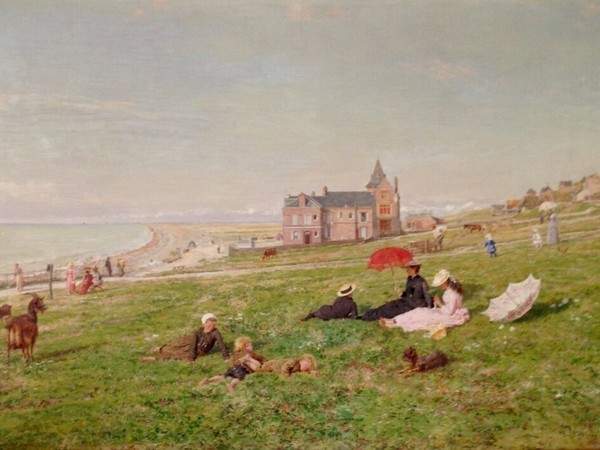A major exhibition at MA*GA dedicated to the protagonists of French and Italian Impressionism
The MA*GA Museum in Gallarate is hosting until January 9, 2022 a major exhibition dedicated to the most celebrated protagonists ofImpressionism, the movement born in France by Claude Monet (Paris, 1840 - Giverny, 1926) from a work he made in 1872 that was presented at the first Impressionist exhibition in 1874: Impression. Soleil Levant. Impressionists. At the Origins of Modernity, this is the title of the exhibition curated by Emma Zanella, director of the MA*GA Museum, Sandrina Bandera, president of the MA*GA Museum, and Vincenzo Sanfo, brings together more than 180 works by the major exponents of French Impressionism and Italian painting of the second half of the 19th century: in fact, Italy too had its Impressionists, first among them and the only one to participate in the 1874 exhibition was Giuseppe de Nittis (Barletta, 1846 - Saint-Germain-en-Laye, 1884). An extensive exhibition traces the main features of the movement through its most distinguished artists: Giovanni Boldini, Paul Cézanne, Gustave Courbet, Giuseppe De Nittis, Edgar Degas, Paul Gauguin, Édouard Manet, Claude Monet, Berthe Morisot, Georges Seurat, and Vincent Van Gogh.
The first Impressionist exhibition was held on April 15, 1874 in photographer Nadar’s studio at 35 Boulevard des Capucines in Paris. A total of thirty artists participated, whose way of painting was totally different from the way painters up to that time conceived their way of working: in the open air, they did not depict the quasi-photographic image of a scene, but intended to return to the viewer what the artist’s eye sees on the canvas, and painted with quick, short brushstrokes rich in color. Even the 1874 exhibition itself was innovative in its exhibition design, designed to make individual works stand out. As John Rewald writes, it was “an exhibition that represents a decisive gesture of challenge and rupture with exhibition customs, with the masters or pseudo-masters of the day, with iconographic and pictorial conventions, with officialdom, bringing to the Parisian art scene new ideas and revolutionary painting, the legitimate heir to decades of experimentation, argumentation, and reflection on the role of art in society and its independence of language and vision.”
MA*GA’s review starts from these very premises, intending to be an exhibition itinerary that can help the public understand the transformations of art in Europe in the second half of the 19th century. On display are paintings, sculptures, drawings. engravings to decorative art objects.
Divided into five sections, each introduced by the verse and prose of some great poets and writers, the exhibition weaves photography, applied arts, fashion and literature into its narrative.
It opens with Correspondances, which refers to the title from Baudelaire’s famous poem written in 1873. Just as in the poem the author entrusts the poet with the ability to understand the language of flowers and mute things, in the same way artists treat nature with new and surprising feelings, capturing its grace and classicism, but also its grandeur and monumentality.
This is followed by the section Le ventre de Paris, a title that refers to Emile Zola’s novel of the same year (1873): it is in this environment that modernity will develop; this section highlights the dual soul of that period, between rural life and city life.
In the section La Comédie humaine the literary connection with Honoré de Balzac. Just as Balzac sought to shape, in his Comédie, a kind of fresco of the “social species” of man and life, with the intention of encapsulating his entire era in his work, in the same way this section aims to bring together the artists, writers, composers and critics who animated Parisian cultural life, determining the birth of Impressionism.
The exhibition proceeds with Le peintre de la vie moderne, a section whose literary reference is still Baudelaire, but this time in the guise of an art critic. The artists featured in this section describe and embody through their work the concept of modernity. Also exhibited are significant objects from this new era, such as Braquemont’s ceramics, Emile Gallé’s glassware, and some precious clothes on loan from Italian and French collections.
The exhibition concludes with À rebours, the section that refers from a literary point of view to Huysmans’ novel that fully represents fin de siècle Paris. Great artists, such as Cézanne, Degas, Gauguin, and Toulouse-Lautrec, lead the arts to Post-Impressionism and Symbolism, and then to the Avant-Garde.
The exhibition is sponsored by MA*GA, City of Gallarate and HIC, in collaboration with RJMA Progetti Culturali and Diffusione Italia - International Group, with contributions from Regione Lombardia, Fondazione Cariplo, Ricola, Lamberti.
For more info: www.museomaga.it
Hours: Tuesday to Friday from 10 a.m. to 6 p.m., Saturday and Sunday from 11 a.m. to 7 p.m. Closed Mondays.
Image: Firmin-Girard, Prairie et Villas (circa 1880).
 |
| A major exhibition at MA*GA dedicated to the protagonists of French and Italian Impressionism |
Warning: the translation into English of the original Italian article was created using automatic tools. We undertake to review all articles, but we do not guarantee the total absence of inaccuracies in the translation due to the program. You can find the original by clicking on the ITA button. If you find any mistake,please contact us.




























